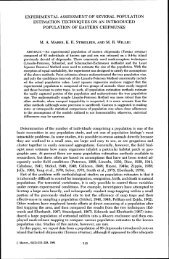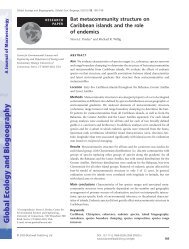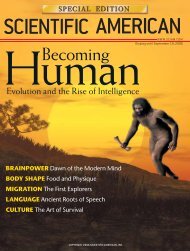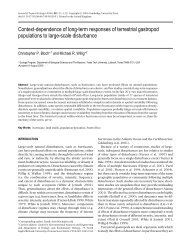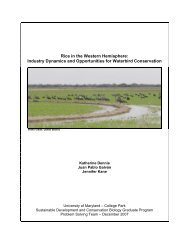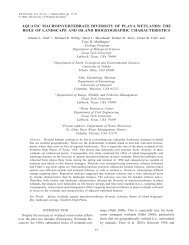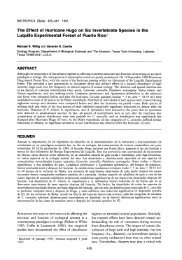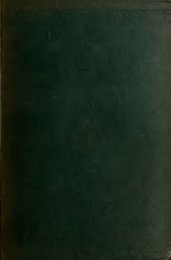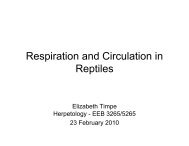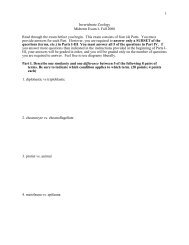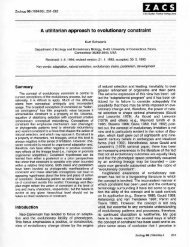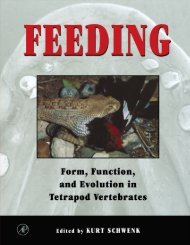Tadpole shrimp structure macroinvertebrate communities in playa ...
Tadpole shrimp structure macroinvertebrate communities in playa ...
Tadpole shrimp structure macroinvertebrate communities in playa ...
Create successful ePaper yourself
Turn your PDF publications into a flip-book with our unique Google optimized e-Paper software.
140<br />
impermeable floors that usually collect water<br />
dur<strong>in</strong>g early spr<strong>in</strong>g ra<strong>in</strong>s and desiccate <strong>in</strong> late<br />
summer or fall (Haukos & Smith, 1994; Anderson<br />
& Smith, 2004). Because <strong>playa</strong>s are ephemeral,<br />
many resident <strong>in</strong>vertebrates lack<strong>in</strong>g autonomous<br />
means for emigration have evolved specialized life<br />
cycles and physical adaptations for surviv<strong>in</strong>g<br />
drought (Belk & Cole, 1975; Wigg<strong>in</strong>s et al., 1980;<br />
Pennak, 1989; Anderson & Smith, 2004). For<br />
example, the rest<strong>in</strong>g cysts of branchiopods and<br />
diapaus<strong>in</strong>g eggs of ostracods require environmental<br />
stimulus to eclose, such as changes <strong>in</strong> oxygen<br />
concentration, light, or temperature, which occur<br />
when <strong>playa</strong>s fill with spr<strong>in</strong>g ra<strong>in</strong>s. More than 60<br />
species of <strong>macro<strong>in</strong>vertebrate</strong>s reside <strong>in</strong> <strong>playa</strong>s, or<br />
use them as breed<strong>in</strong>g or forag<strong>in</strong>g sites (Sublette &<br />
Sublette, 1967; Merickel & Wangberg, 1981;<br />
Haukos & Smith, 1994; Hall et al., 1999; Anderson<br />
& Smith, 2004). However, diversity of <strong>in</strong>vertebrates<br />
differs greatly among <strong>playa</strong>s, depend<strong>in</strong>g<br />
partly on the persistence of water and surround<strong>in</strong>g<br />
landuse practices (Sublette & Sublette, 1967;<br />
Rhodes & Garcia, 1981; Hall et al., 1999; Hall<br />
et al., 2004).<br />
In <strong>playa</strong> lakes, tadpole <strong>shrimp</strong> are primarily<br />
benthic detrital feeders that are abundant dur<strong>in</strong>g<br />
the first few weeks of <strong>playa</strong> development (Sublette<br />
& Sublette, 1967; Moorhead et al., 1998). They<br />
forage ma<strong>in</strong>ly by plow<strong>in</strong>g through the sediment<br />
(Dodson & Frey, 1991), but opportunistically<br />
consume other <strong>in</strong>vertebrates (Ardo, 1948; Dodson,<br />
1987; Pennak, 1989; Christoffersen, 2001). <strong>Tadpole</strong><br />
<strong>shrimp</strong> have strong effects on abundance of<br />
dipteran prey species <strong>in</strong> ponds (Dodson, 1987;<br />
Walton, 2001) and may even be useful biologicalcontrol<br />
agents for mosquitoes (Tietze & Mulla,<br />
1991; Fry et al., 1994). We hypothesize that tadpole<br />
<strong>shrimp</strong> substantially affect the abundance and<br />
diversity of <strong>in</strong>vertebrates <strong>in</strong> <strong>playa</strong> lakes. Consequently,<br />
their removal should alter community<br />
composition and diversity of <strong>macro<strong>in</strong>vertebrate</strong><br />
<strong>communities</strong>.<br />
Materials and methods<br />
Experimental procedures<br />
Macro<strong>in</strong>vertebrate <strong>communities</strong> can be established<br />
<strong>in</strong> laboratory microcosms by simply add<strong>in</strong>g water<br />
to <strong>playa</strong> soil conta<strong>in</strong><strong>in</strong>g drought-resistant stages<br />
(Anderson & Smith, 2004). These microcosms can<br />
be replicated, controlled, and manipulated <strong>in</strong> ways<br />
that are difficult or impossible to achieve <strong>in</strong> situ,<br />
such as the selective removal of tadpole <strong>shrimp</strong>.<br />
Additionally, non-resident migrants, especially<br />
predaceous <strong>in</strong>sects, can be excluded so that effects<br />
of tadpole <strong>shrimp</strong> on the resident community may<br />
be exam<strong>in</strong>ed without complications <strong>in</strong>troduced by<br />
idiosyncratic presence of other predators.<br />
To exam<strong>in</strong>e the effects of tadpole <strong>shrimp</strong> on<br />
<strong>macro<strong>in</strong>vertebrate</strong> community <strong>structure</strong> of <strong>playa</strong><br />
microcosms, we established microcosms of 41<br />
<strong>playa</strong> lakes and compared their <strong>macro<strong>in</strong>vertebrate</strong><br />
<strong>communities</strong> <strong>in</strong> trials with and without tadpole<br />
<strong>shrimp</strong>. Treatment consisted of remov<strong>in</strong>g tadpole<br />
<strong>shrimp</strong> from microcosms; tadpole <strong>shrimp</strong> were<br />
reta<strong>in</strong>ed <strong>in</strong> controls. Because lab space was limited<br />
to 41 aquaria, we conducted 4 separate trials from<br />
April to August <strong>in</strong> a fixed sequence of treatment,<br />
control, treatment, control. For each trial we<br />
established a microcosm for each of the 41 <strong>playa</strong>s,<br />
subjected all 41 microcosms to either treatment or<br />
control, and ma<strong>in</strong>ta<strong>in</strong>ed them for approximately<br />
one month. Microcosms were torn down at the<br />
end of each trial and re-established with fresh soil<br />
for the next trial.<br />
Microcosms were established for each <strong>playa</strong> <strong>in</strong><br />
each trial from soil samples collected from 41 <strong>playa</strong>s<br />
<strong>in</strong> a 4-county area (Crosby, Floyd, Hale, and<br />
Lubbock) surround<strong>in</strong>g Lubbock, TX (see Hall<br />
et al., 2004 for details on <strong>playa</strong> lakes used <strong>in</strong> this<br />
study). Samples were obta<strong>in</strong>ed dur<strong>in</strong>g the previous<br />
dry season, from November to January, after soils<br />
had been dry for 1–3 months. In each of the 41<br />
<strong>playa</strong>s, 40 random cores (5 cm deep, 6.4 cm diameter)<br />
were collected and comb<strong>in</strong>ed to form a s<strong>in</strong>gle,<br />
well-mixed soil sample. At the beg<strong>in</strong>n<strong>in</strong>g of each<br />
trial, laboratory microcosms were established for<br />
each <strong>playa</strong> by add<strong>in</strong>g 4 gal of distilled water to<br />
800 g soil <strong>in</strong> a 18.9 l (5 gal) aquarium. Aquaria<br />
were ma<strong>in</strong>ta<strong>in</strong>ed <strong>in</strong> a climate-controlled greenhouse<br />
(humidity: 60–70%, temperature: 29–35 °C). To<br />
reduce evaporative water loss and prevent <strong>in</strong>vasion<br />
of aquaria by greenhouse pests, each aquarium was<br />
covered with a clear acrylic or glass plate.<br />
For all trials, we sampled each microcosm one<br />
week after establishment by non-destructively<br />
siphon<strong>in</strong>g water through an aquatic D-net, leav<strong>in</strong>g<br />
the bottom layer of soil undisturbed. For treatment



